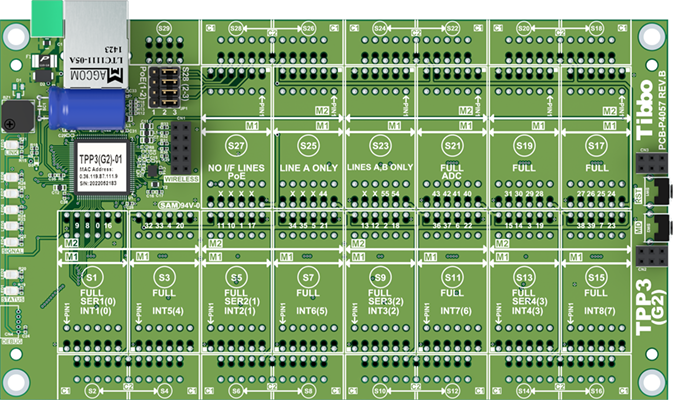Size 3 Tibbo Project PCB (TPP3), Gen. 2

Gen. 2 Performance Highlights
The TPP3(G2) is a high-performance upgrade to the original TPP3. Here is a list of important improvements:
- 32-bit architecture (vs. 16-bit architecture of the TPP3)
- Five to 80 times better performance, depending on the calculations and variable types
- Seven times faster GPIO manipulation
- Three times larger available user SRAM (66KB vs. 22KB)
- Two times larger flash memory (1MB for TiOS/code + 1MB for the file system vs. 1MB total for TiOS, code, and file system)
- 1.6 times lower power consumption (140mA vs. 220mA)
- Four-channel ADC
- The ability to update TiOS firmware and compiled Tibbo BASIC/C app over-the-air (this requires the WA2000 and an iOS or Android device)
- Watchdog via sys. Object
Introduction
The Size 3 Tibbo Project PCB (TPP3), Gen. 2 runs Tibbo OS (TiOS) and is programmable in Tibbo BASIC and Tibbo C.
The TPP3(G2) is ideal for applications that require no human-machine interface (HMI) while calling for a significant number of I/O lines and/or functions.
The board can be used to replace dumb programmable logic controllers (PLC) or work as a safety, security, or access control device. The TPP3(G2) is also ideal for factory, lab, shop, building, hotel, and home automation projects.
Offering seven tiles for a total of 14 "M" and 14 "C" sockets, the TPP3(G2) can be used to construct devices with up to four full serial ports, up to 25 relays, or up to 47 opto-inputs, pulse-width modulation (PWM), or open-collector outputs.
Further, the generous number of available Tibbit sockets means you can increase your system's versatility by offering multiple power supply options, such as +5V, +12V, PoE, etc. You can also install multiple power supply Tibbits to increase total available power or provide power redundancy.
This product can be used as a bare board or assembled into a Size 3 Tibbo Project Box (TPB3).
Hardware Features
- 32-bit architecture
- 10/100BaseT auto-MDIX Ethernet port (automatic detection of "straight" and "cross" cables) with an RJ45 connector
- Optional Wi-Fi interface (requires the WA2000 add-on module)
- Optional BLE interface (requires the WA2000 add-on module)
- Optional 4G (LTE) interface (requires Tibbit #45)
- Optional Cat-M1/NB-IoT interface (requires Tibbit #46)
- Seven tiles with 47 general-purpose I/O lines
- Fourteen sockets for Tibbit modules
- Fourteen sockets for Tibbit connectors
- One extra socket for Tibbit #37
- Four Tibbit module sockets have UART capability
- Baudrates of up to 921,600bps
- None*/even/odd/mark/space parity modes
- 7*/8 bits/character
- Full-duplex mode with RTS/CTS and XON/XOFF flow control
- Half-duplex mode with direction control
- Encoding and decoding of Wiegand and clock/data streams
- Eight module sockets have interrupt capability
- One module socket has four ADC lines
- One module socket has PoE capability
- Four remappable synchronous serial ports with SPI and I2C modes
- Onboard buzzer (consumes 50mA more current if used)
- MD and RST buttons
- RTC with a backup supercapacitor
- 66KB SRAM for Tibbo BASIC/C variables and data
- 1MB flash for TiOS and application code
- Additional 1MB flash for the hardened fault-tolerant file system
- 2048-byte EEPROM for data storage
- Eight onboard LEDs
- Green and Red main status LEDs
- Yellow Ethernet link LED
- Five blue LEDs (for Wi-Fi signal strength indication, etc.)
- Reliable power-on/ brown-out reset circuit
- Power:
- 140mA @ 5V (100Base-T mode, full speed, buzzer off)
- 190mA @ 5V (100Base-T mode, full speed, buzzer on)
- Dimensions (LxW): 165 x 94mm
- Operating temperature range: -40°C to 70°C
- Firmware is upgradeable through
- The serial port
- Ethernet LAN
- Over-the-air (requires the WA2000)
- Tibbo BASIC/C application can be debugged through the Ethernet LAN
- CE and FCC-certified
* The TPP3(G2) does not support the combination of 7 bits/character mode and the "none" parity mode.
Programming Features
The TPP3(G2) runs Tibbo OS (TiOS). The following is a list of the features supported by its programming platform:
- Objects:
- adc — provides access to four ADC channels
- beep — generates buzzer patterns
- button — monitors the MD button
- fd — manages the flash memory file system and direct sector access
- i2c — implements up to eight software I²C channels on the general-purpose I/O lines
- io — handles I/O lines, ports, and interrupts
- kp — works with matrix and binary keypads
- lcd — controls the LCD
- net — controls the Ethernet port
- pat — "plays" patterns on up to five LED pairs
- ppp — accesses the Internet over a serial modem (GPRS, etc.)
- pppoe — accesses the Internet over an ADSL modem
- romfile — facilitates access to resource files (fixed data)
- rtc — keeps track of date and time
- ser — controls serial ports (UART, Wiegand, clock/data modes)
- sock — socket comms (up to 32 UDP, TCP, and HTTP sessions)
- ssi — controls serial synchronous interface channels (SPI, I²C...)
- stor — provides access to the EEPROM
- sys — in charge of general device functionality
- wln — handles the Wi-Fi interface
- 27 string functions, 8 date/time conversion functions, encryption/hash calculation functions (RC4, MD5, SHA-1), and more
- Function groups: String functions, trigonometric functions, date/time conversion functions, encryption/hash calculation functions (AES, RC4, MD5, SHA-1), and more
